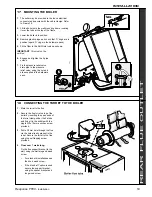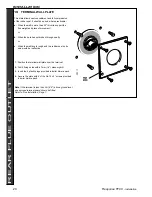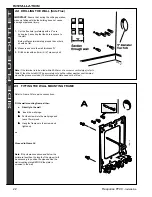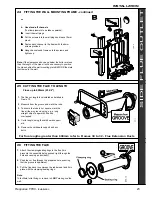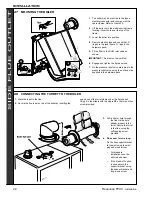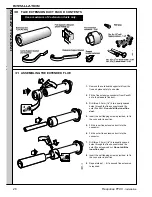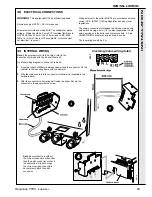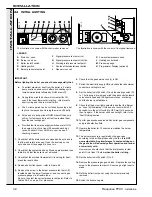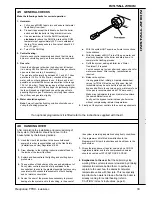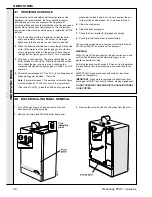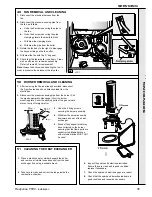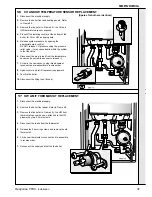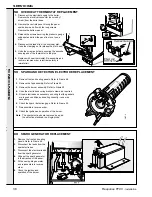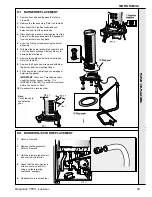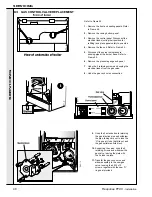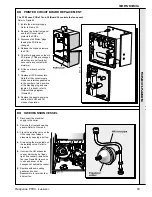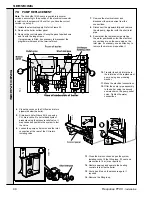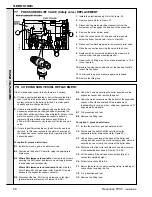
33
Response FF80
- Installation
45 GENERAL CHECKS
INSTALLATION
INST
ALLA
TION
1.
Hand the User's Instructions to the householder and
explain his or her responsibilities under the Gas Safety
(Installation and Use) Regulations 1994.
2.
Draw attention to the Lighting Instruction label affixed to
the inside of the lower front door.
3.
Explain and demonstrate the lighting and shutting down
procedures.
4.
The operation of the boiler and the use and adjustment of
ALL system controls should be fully explained to the
householder, to ensure the greatest possible fuel economy
consistent with household requirements of both heating
and hot water consumption.
5.
Advise the user of the precautions necessary to prevent
damage to the system and to the building, in the event of
the system remaining inoperative during frosty conditions.
6.
If a programmer kit is fitted, draw attention to the
Programmer Kit User's Instructions and hand them to the
householder.
7.
Stress the importance of regular servicing by a CORGI
registered installer and that a comprehensive service
should be carried out AT LEAST ONCE A YEAR.
8.
Emphasise to the user
that the boiler may stop
working if the system pressure is lowered by draining
radiators to decorate behind them. In particular,
explain to the user how the domestic hot water
temperature varies with flow rate. This is especially
important when water is drawn off while the boiler is
already running for central heating (refer to
'CAUTION' in User's Instructions, page 2).
After completing the installation and commissioning of
the system, the installer should hand over to the
householder by the following actions:
46 HANDING OVER
If an optional programmer kit is fitted refer to the instructions supplied with the kit.
Make the following checks for correct operation:
1. Hot water:
a.
Fully open all DHW taps in turn and ensure that water
flows freely from them.
b.
Close all taps except the furthest one from the boiler
and check that the boiler is firing at maximum rate.
c.
Use a screwdriver to turn the DHW flow adjuster
clockwise
to reduce the DHW flow rate until a DHW
temperature of approximately 35
o
C rise is obtained at
the tap. This corresponds to a flow rate of about 9.6 l/
min. (2.1 gpm).
d.
Turn off the DHW tap.
2. Central heating:
Operate each control separately and check that the main
burner or circulating pump, as the case may be, responds.
3. Gas rate:
Check the boiler gas rate when the boiler is at full output
(i.e. serving HW at a flow rate of at least 8 litres per minute,
open more than one tap if necessary).
The gas rate will normally be between 43.1 and 47.7 litres
per minute (1.52 to 1.68 cu/ft min.), checked at the gas
meter, with no other appliance in use. If this check is not
possible, ensure that the burner pressure lies in the range
13.3 to 16.4 mbar). These figures apply at the nominal UK
mains voltage of 230V: if the voltage is significantly higher,
the fan will speed up slightly and cause the gas valve to
pass slightly more gas. Conversely, very long flues reduce
the air flow, and gas rate, slightly.
4. Water circulation system:
Note.
Fernox Superfloc flushing solution should be used
during the flushing procedure.
a.
With the system HOT examine all water connections
for soundness.
b.
With the system still HOT, turn off the gas, water and
electricity supplies to the boiler and drain down, to
complete the flushing process.
c.
Refill the system, adding inhibitor (see 'Water
Treatment'), if required.
Vent as necessary to clear all air and, again, check for
water soundness. After venting, repressurise as
required.
d.
Balance the system.
It is suggested that, initially, all radiator handwheel
valves (or TRVs if fitted) be set fully open, that all
lockshield valves be set a half-turn open and the
bypass a half-turn to one turn open (a minimum of one
turn open is recommended when TRVs are used.)
Make minor adjustments to each radiator to achieve
the same differential on all.
Lastly, set the bypass to eliminate any boiler noise,
without compromising radiator temperatures.
5.
Finally, set the system controls to the user’s requirements.

